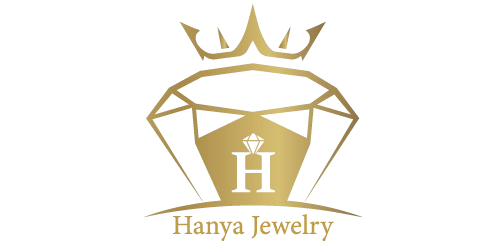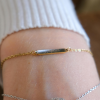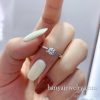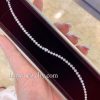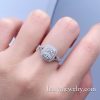When shopping for diamonds, you’ll often hear the term 4Cs of Diamonds. This essential guide helps you understand the key factors that influence the value and beauty of a diamond. The 4Cs—Cut, Color, Clarity, and Carat Weight—are universally recognized standards that determine a diamond’s quality and price. In this in-depth guide, we’ll break down each of these characteristics to help you make an informed decision when purchasing a diamond.
1. What Are the 4Cs of Diamonds?
The 4Cs of Diamonds—Cut, Color, Clarity, and Carat Weight—were introduced by the Gemological Institute of America (GIA) as a standardized way to evaluate diamond quality. These four criteria are the foundation for determining a diamond’s beauty, value, and price. Whether you’re buying a diamond engagement ring, a pendant, or diamond earrings, understanding these factors will help you make a wise choice.
2. Cut: The Sparkle Factor
Cut is often considered the most crucial of the 4Cs because it directly impacts how a diamond sparkles. Even if a diamond has flawless clarity and perfect color, it won’t dazzle unless it’s cut properly.
What is Diamond Cut?
Diamond cut refers to how well a diamond’s facets interact with light. A well-cut diamond reflects light from one facet to another, creating that iconic brilliance and sparkle. It’s not to be confused with the shape (such as round, oval, or princess), but rather the quality of the cutting craftsmanship.
Why Diamond Cut Matters
A diamond with an excellent cut can make a smaller carat weight appear larger and more brilliant. Poorly cut diamonds will look dull and lack the sparkle we associate with a high-quality gem. The cut affects three critical factors:
- Brilliance: The white light reflected off the diamond.
- Fire: The dispersion of light into the colors of the spectrum.
- Scintillation: The sparkle seen when the diamond is moved.
Types of Diamond Cuts
There are several standard diamond cuts, including:
- Ideal/Excellent Cut: Reflects almost all the light, providing maximum brilliance.
- Very Good Cut: A step down from the ideal cut but still offers great sparkle.
- Good Cut: Decent brilliance but less sparkle compared to the higher grades.
- Fair Cut: Light escapes from the bottom or sides, resulting in reduced brilliance.
- Poor Cut: Lacks sparkle due to improper proportions or symmetry.
When shopping for a diamond, aim for at least a “Very Good” cut to ensure it has sufficient brilliance.
3. Color: Purity in Appearance
Color refers to the presence of any hue within a diamond. The less color a diamond has, the higher its value. Completely colorless diamonds are rare and highly sought after.
What is Diamond Color?
Diamonds are graded on their colorlessness. Most diamonds have some yellow or brown tints, and the less noticeable this color, the more valuable the diamond becomes.
The GIA Color Scale Explained
The GIA color scale ranges from D (colorless) to Z (light color):
- D-F: Colorless. These diamonds are rare and highly valuable.
- G-J: Near colorless. These diamonds appear colorless to the naked eye but have slight traces of color when viewed under magnification.
- K-M: Faint color. The diamond has a noticeable yellow tint, especially in larger carat sizes.
- N-Z: Noticeable color. These diamonds display noticeable yellow or brown hues.
For most buyers, a diamond in the G-H range offers the best value. They appear nearly colorless but come at a more affordable price than D-F diamonds.
How Color Impacts Value
A diamond’s color grade can significantly impact its price. A D-grade diamond is worth much more than a G or H, even though the visual difference may be minimal. However, some fancy-colored diamonds, such as pinks or blues, can be even more valuable due to their rarity.
4. Clarity: The Inner Perfection
Clarity refers to the presence of internal or external imperfections, known as inclusions and blemishes, respectively. These imperfections form naturally during the diamond’s creation and can affect its overall appearance and value.
What is Diamond Clarity?
Diamond clarity measures how free a diamond is from these imperfections. While no diamond is absolutely perfect under magnification, diamonds with fewer and less noticeable flaws are more desirable and valuable.
Understanding Diamond Inclusions and Blemishes
- Inclusions: Internal characteristics, such as crystals, feathers, or clouds, that form within the diamond.
- Blemishes: External characteristics, such as scratches or nicks, found on the surface of the diamond.
GIA Clarity Grading Scale
The GIA clarity scale ranges from Flawless (FL) to Included (I):
- FL-IF (Flawless to Internally Flawless): No visible inclusions even under 10x magnification.
- VVS1-VVS2 (Very, Very Slightly Included): Minor inclusions that are difficult to see even under magnification.
- VS1-VS2 (Very Slightly Included): Inclusions are visible under 10x magnification but not to the naked eye.
- SI1-SI2 (Slightly Included): Noticeable inclusions that may or may not be visible to the naked eye.
- I1-I3 (Included): Obvious inclusions visible to the naked eye, which can affect transparency and brilliance.
For a balance between clarity and cost, diamonds in the VS1-SI1 range are ideal. These offer good clarity without the high price tag of flawless diamonds.
5. Carat Weight: The Size Factor
Carat Weight measures the size of a diamond. It’s often the first thing people think about when evaluating a diamond’s worth, but bigger doesn’t always mean better.
What is Carat Weight?
Carat refers to the weight of the diamond, with one carat equaling 200 milligrams. While larger diamonds are rarer and more expensive, carat weight alone doesn’t determine a diamond’s value or beauty.
Does Size Equal Quality?
A diamond’s carat weight is just one of the 4Cs, and it should be considered in combination with the cut, color, and clarity. A large diamond with poor cut, color, or clarity won’t sparkle as much as a smaller, well-proportioned diamond.
Here’s how carat weight generally influences a diamond’s appearance:
- 0.25 – 0.50 carats: Delicate and elegant, perfect for everyday wear.
- 0.50 – 1.00 carat: Classic and timeless, offering good presence without being too large.
- 1.00 – 2.00 carats: Strikes a balance between size and affordability, making it a popular choice for engagement rings.
- 2.00+ carats: Eye-catching and extravagant, but can become exponentially more expensive.
6. How the 4Cs Work Together
The 4Cs—Cut, Color, Clarity, and Carat Weight—are interdependent. You can’t judge a diamond’s beauty or value based on one C alone. For example, a large carat diamond with poor clarity and cut will look less appealing than a smaller, well-cut diamond with excellent clarity. Balancing the 4Cs according to your budget and preferences will ensure you get the best value for your money.
7. Why the 4Cs Are Important When Buying a Diamond
Understanding the 4Cs allows you to evaluate a diamond objectively. With this knowledge, you can prioritize which aspects are most important to you. If sparkle and brilliance are your main concerns, focus on cut. If you’re after size, then carat weight may be your priority. Knowing the 4Cs also helps you navigate pricing differences and make an informed decision that meets both your aesthetic and financial needs.
Conclusion
Choosing a diamond can be a daunting task, but understanding the 4Cs of Diamonds—Cut, Color, Clarity, and Carat Weight—makes it easier. Each of these factors plays a vital role in the beauty, value, and longevity of your diamond. Whether you’re looking for an engagement ring or a special gift, knowing how to evaluate these characteristics will ensure you make a purchase you’ll cherish forever.
